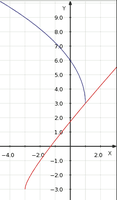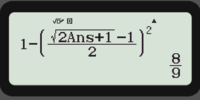WafflesPancakes
New member
- Joined
- Jun 7, 2021
- Messages
- 5
[MATH]x + \sqrt{x+3} = 3 + 3\sqrt{1-x}[/MATH]
@HoIGet rid of the square roots by squaring!
\(\displaystyle \sqrt{x+ 3}= 3- x+ \sqrt{1- x}\)
\(\displaystyle x+ 3= (3- x)^2+ 2(3- x)\sqrt{1- x}+ 1- x= 10- 7x+ x^2+ (6-2x)\sqrt{1- x}\)
\(\displaystyle x^2- 8x+ 7= (2z- 6)\sqrt{1- x}\)
Square again:
\(\displaystyle x^4- 9x^3+ 7x^2- 8x^3+ 64x^2- 56x+ 7x^2- 56x+ 49= (4x^2- 24x+ 36)(1- x)= 4x^2- 24x+ 36- 4x^3+ 24^2- 36x\)
\(\displaystyle x^4- 17x^3+ 78x^2- 112x+ 49= -4x^3+ 28x^2-60x+ 36\)
\(\displaystyle x^4- 13x^3+ 50x^2- 52x+ 13= 0\).
Get rid of the square roots by squaring!
\(\displaystyle \sqrt{x+ 3}= 3- x+ \sqrt{1- x}\)
\(\displaystyle x+ 3= (3- x)^2+ 2(3- x)\sqrt{1- x}+ 1- x= 10- 7x+ x^2+ (6-2x)\sqrt{1- x}\)
\(\displaystyle x^2- 8x+ 7= (2z- 6)\sqrt{1- x}\)
Square again:
\(\displaystyle x^4- 9x^3+ 7x^2- 8x^3+ 64x^2- 56x+ 7x^2- 56x+ 49= (4x^2- 24x+ 36)(1- x)= 4x^2- 24x+ 36- 4x^3+ 24^2- 36x\)
\(\displaystyle x^4- 17x^3+ 78x^2- 112x+ 49= -4x^3+ 28x^2-60x+ 36\)
\(\displaystyle x^4- 13x^3+ 50x^2- 52x+ 13= 0\).
Continuing the theme from a recent thread...
Only goes to support that - practice makes you lucky.....@Cubist
Nice work.
I'm afraid for my method you cannot be sure that you are going to narrow it down to one potential solution. There was a large element of luck just.
@Cubist
Nice work.
I'm afraid for my method you cannot be sure that you are going to narrow it down to one potential solution. There was a large element of luck just.
I'm afraid for my method you cannot be sure that you are going to narrow it down to one potential solution. There was a large element of luck just.
Only goes to support that - practice makes you lucky.....
u=-2 is a (possible) solution? Where did that come from or was it a small error on your part?Here's a way of doing the original question by squaring...
[math]x + \sqrt{x+3} = 3 + 3\sqrt{1-x}[/math]
Make the following substitution to "remove" a sqrt
[math]u = \sqrt{1-x} \implies u^2 = 1-x \implies x=1-u^2[/math]
[math]1 - u^2 + \sqrt{4-u^2} = 3 + 3u\\ \sqrt{4-u^2} = u^2 + 3u + 2\\ \sqrt{(2-u)(u+2)} = (u + 2)(u + 1)[/math]Then square EDIT: I initially tried this without factoring on the line above, and that led to a quite a mess!
[math](2 - u)\bcancel{(u + 2)} = (u + 2)^{\bcancel{2}}(u + 1)^2[/math]
u=-2 is a solution
[math](2 - u) = (u + 2)(u + 1)^2\\ 2 - u = u^3 + 4u^2 + 5u + 2\\ 0 = u^3 + 4u^2 + 6u\\ 0 = \bcancel{u} (u^2 + 4u + 6)[/math]u=0 is a solution. Getting back to x values...
[math]u=0 \implies x=1\\ u=-2 \implies x=-3[/math]Plugging back into the original reveals that x=1 is the only valid solution of the two.
Here are some main (and lesser) steps of a partial solution that is similar
in manner to post # 9...
\(\displaystyle \ \ \) Jomo, look how u = -2 makes each side zero in Cubist's
u-variable equation right above that.
Also, Cubist's equation where u = -2 as a candidate is equivalent to:
\(\displaystyle (2 - u)(u + 2) - (u + 2)^2(u + 1)^2 = 0 \)
Well if you have something that you could block the value in, both ways then i guess you could do it?! Maybe...



